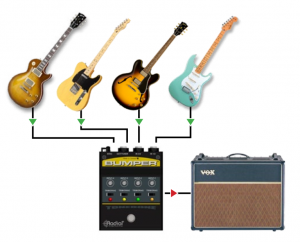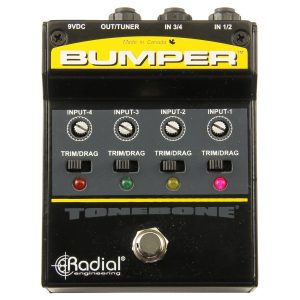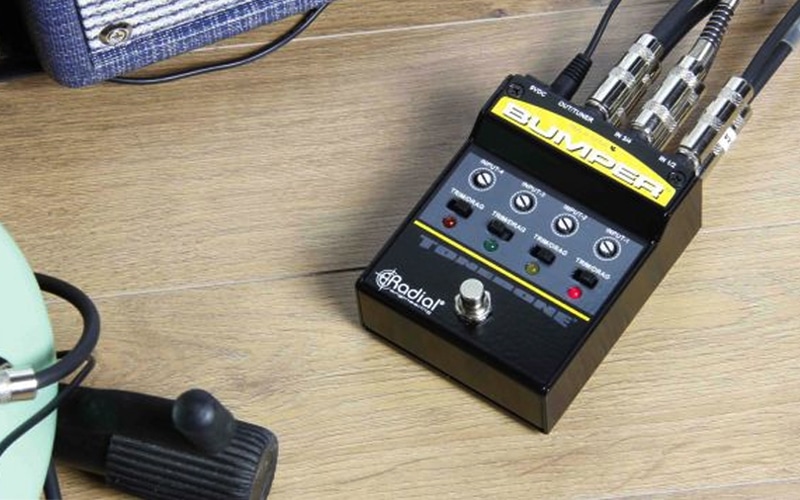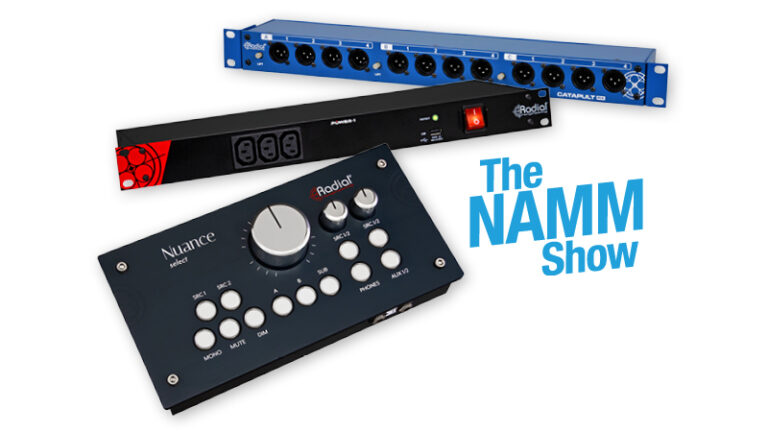There has never been a time in our musical history where so many different musical styles and sounds have blended together. Top 40 bands will transition between funk, reggae, hip-hop, rock, country and bluegrass while the audience follows without losing a beat. In concert, multi-instrumentalists seem to be on every stage switching between acoustic guitar, fiddle, mandolin, keyboard and even a wind instrument.
The challenge here is obvious: how do you quickly and professionally transition between instruments without having to readjust the stage volume each time? And then what about the pedalboard? With transportation costs being so high, musicians are constantly fighting to reduce the size of their luggage while maximizing performance. The Bumper is a result of Radial addressing these solutions.
 Maximum inputs in a small package
Maximum inputs in a small package
The traditional approach to a 4-instrument stage selector is to use four dedicated switches. Although this works admirably, it also requires a ton of space on a pedalboard. Instead, we came up with a solution using a single footswitch that sequentially advances through the inputs each time you depress it. We then added nice bright LED indicators that are visible under various stage conditions to let you know exactly what input is active. To keep the size as small as possible, we then employed stacking ¼” instrument jacks. These take up half the space resulting in more room on the pedalboard. Another cool thing about these switches is that they are actually switching jacks that – when not in use – are ignored by the switching circuit. This way, should you have two or three basses connected, the footswitch sequence will only count up to the number of inputs that are in use and then start over.
Tone, tone and nothing but tone
If you are familiar with Radial, you know that retaining the natural tone of the instrument is mandatory. The Bumper is no exception. As soon as you connect your favorite axe to the input, you immediately encounter a dual-wafer switch that can be set to Drag or Trim. Radial invented Drag™ control in 2001 with the launch of the Radial JD7 Injector™. We discovered that when a buffer is introduced into the circuit, it can make a guitar sound glassy or excessively edgy if not kept in check. Drag lets you adjust the load on the pickup to replicate the tone and feel as if connected directly to a tube amp. This also allows you to compensate for extra long cables should they be in use. The signal then passes through Radial’s coveted Class-A buffering circuit which lowers the impedance and reduces susceptibility to noise. Unlike chip-based switchers, the Bumper’s 100% discrete front end does not employ any negative feedback whatsoever to deliver your tone. This eliminates harsh odd-order harmonics, excessive phase shift or artefact.
Double duty for twice the performance
 Another very cool feature is the way the Bumper incorporates and makes use of four custom made dual-wafer potentiometers. This design enables each of the wafers to be assigned a specific task whereby one wafer can be used to set the Drag™ control for passive instruments while the other side can be used as a Trim control for louder active sources. You simply set the potentiometer function to the desired task using the sliderswitch. This way you can easily switch from a low output vintage Fender® bass on input-1 set to Drag, to a high output active 5-string on input-2 set to Trim. With the Bumper, both instruments will now play at the same volume. This eliminates having to worry about signal levels in between songs and helps the audio engineer as they no longer need to ride the mixer channel at every changeover.
Another very cool feature is the way the Bumper incorporates and makes use of four custom made dual-wafer potentiometers. This design enables each of the wafers to be assigned a specific task whereby one wafer can be used to set the Drag™ control for passive instruments while the other side can be used as a Trim control for louder active sources. You simply set the potentiometer function to the desired task using the sliderswitch. This way you can easily switch from a low output vintage Fender® bass on input-1 set to Drag, to a high output active 5-string on input-2 set to Trim. With the Bumper, both instruments will now play at the same volume. This eliminates having to worry about signal levels in between songs and helps the audio engineer as they no longer need to ride the mixer channel at every changeover.
Compact with 9V powering
In order to accommodate as many pedalboard setups as possible, the Bumper is powered by a standard 9V supply, such as those used by most pedal manufacturers. This also enables it to be powered using a common multi-pedal power brick instead of a dedicated power supply.

















